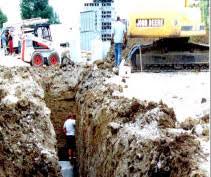Excavation Safety Training

Summary
Trenching and excavations. It is important, before beginning the job, for the contractor to establish and maintain a excavation plan for the work site that provides adequate systematic policies, procedures, and practices to protect employees from, and allow them to recognize, excavations safety and health hazards.
Excavation and trenching are among the most hazardous construction operations. The Occupational Safety and Health Administration’s (OSHA) Excavation standards, 29 Code of Federal Regulations (CFR) Part 1926, Subpart P, contain requirements for excavation and trenching operations.
Trenching and excavation work presents serious hazards to all workers involved. Cave-ins pose the greatest risk and are more likely than some other excavation-related incidents to result in worker fatalities. One cubic yard of soil can weigh as much as a car. An unprotected trench can be an early grave. Employers must ensure that workers enter trenches only after adequate protections are in place to address cave-in hazards. Other potential hazards associated with trenching work include falling loads, hazardous atmospheres, and hazards from mobile equipment.
Trenches 5 feet (1.5 meters) deep or greater require a protective system unless the excavation is made entirely in stable rock. If less than 5 feet deep, a competent person may determine that a protective system is not required.
A competent person is an individual, designated by the employer, who is capable of identifying existing and predictable hazards in the surroundings or working conditions which are unsanitary, hazardous or dangerous to workers, and who is authorized to take prompt corrective measures to eliminate them. Under the Excavation standards, tasks performed by the competent person include:
- Classifying soil
- Inspecting protective systems
- Design structural ramps
- Monitoring water removal equipment and,
- Conducting site inspections
What are the soil classification categories?
Some of the compliance methods permitted under the Excavation standards require a competent person to classify soil and rock deposits as:
- Stable rock – (most stable)
- Type A soil – Clay type soils
- Type B soil – Silt type soils
- Type C soil – Sand type soils (least stable)
See (below) Appendix A to Subpart P of Part 1926 – Soil Classification.
How can employers prevent cave-ins?
OSHA generally requires that employers protect workers from cave-ins by:
- Sloping and benching the sides of the excavation (Appendix B)
- Supporting the sides of the excavation, or (Appendices C, D,and E)
- Placing a shield between the side of the excavation and the work area (Appendix E)
- Selection of Protective Systems (Appendix F)
Other Information:
- OSHA requires employers to provide ladders, steps, ramps, or other safe means of egress for workers working in trench excavations 4 feet (1.22 meters) or deeper. The means of egress must be located so as not to require workers to travel more than 25 feet (7.62 meters) laterally within the trench.
- Keep heavy equipment away from trench edges. Identify other sources that might affect trench stability.
- Keep excavated soil (spoils) and other materials at least 2 feet (0.6 meters) from trench edges.
- Know where underground utilities are located before digging.
- Test for atmospheric hazards such as low oxygen, hazardous fumes and toxic gases when > 4 feet deep.
- Inspect trenches at the start of each shift.
- Inspect trenches following a rainstorm or other water intrusion.
- Do not work under suspended or raised loads and materials.
- Inspect trenches after any occurrence that could have changed conditions in the trench.
- Ensure that personnel wear high visibility or other suitable clothing when exposed to
vehicular traffic.
Excavation Safety Training Resources
Topics covered in this video include:
- The hazards of trenching.
- The competent person and worksite inspection.
- Soil types and protective systems.
- Ongoing inspection and testing.
- Access, egress, setback and equipment.
1926 Subpart P App A – Soil Classification
1926 Subpart P App B – Sloping and Benching
1926 Subpart P App C – Timber Shoring for Trenches
1926 Subpart P App D – Aluminum Hydraulic Shoring for Trenches
1926 Subpart P App E – Alternatives to Timber Shoring
1926 Subpart P App F – Selection of Protective Systems
Excavation Safety Written Plan